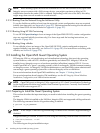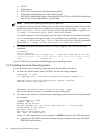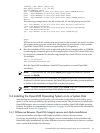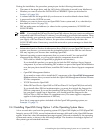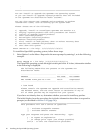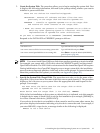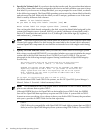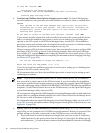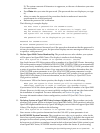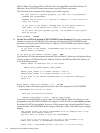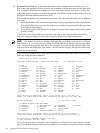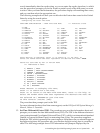
4. Specify the Volume Label: If you select a device that can be used, the procedure then informs
you of the volume label currently assigned to this device and asks whether you want to keep
that label. If you choose not to keep that label, you are prompted for a new label, as shown
in the following example. The OpenVMS operating system uses the volume label to identify
and reference the disk. Make sure the label you use is unique; problems occur if the same
label is used by different disk volumes.
DKB400: is now labeled V84SYS.
Do you want to keep this label? (Yes/No) [Yes] NO
Enter volume label for target system disk: [I64SYS] I64084
You can keep the label already assigned to the disk, accept the default label assigned by the
system (for Integrity server systems, I64SYS), or specify a different volume label (with a
limit of 12 characters that can include A to Z, 0 through 9, the dollar sign ($), hyphen (-),
and underscore (_) characters).
NOTE: OpenVMS requires that the volume labels for all disks on your system or OpenVMS
Cluster have unique labels. If a disk having the same label as the system disk is mounted,
various OpenVMS components do not function as intended or a node might crash during
boot.
5. Specify On-Disk Structure Level: After you enter the volume label for the target system
disk, when you selected INITIALIZE, you are asked whether you want to initialize the target
system disk with On-Disk Structure Level 2 (ODS-2) or Level 5 (ODS-5). The second
paragraph in the following example appears during installations of OpenVMS Integrity
servers only.
The target system disk can be initialized with On-Disk Structure
Level 2 (ODS-2) or Level 5 (ODS-5). (? for more information)
OpenVMS I64 systems include WBEM Services for OpenVMS; the WBEM data
repository requires an ODS-5 disk. If you choose to initialize the
target system disk with ODS-5 the repository can be on the system
disk; otherwise you will need to provide an additional ODS-5 disk.
(? for more information).
Do you want to initialize with ODS-2 or ODS-5? (2/5/?)
For details about ODS-2 and ODS-5 file systems, see the HP OpenVMS System Manager's
Manual, Volume 1: Essentials. A brief summary follows.
NOTE: HP recommends that your system disk be initialized in ODS-5 format, unless you
plan to use software that requires ODS-2.
Although WBEM Services for OpenVMS can be installed on an ODS-2 disk, the WBEM
Services for OpenVMS data repository requires an ODS-5 disk. A system disk in ODS-5
format can store everything; if you choose to have your disk in ODS-2 format, the procedure
asks you to provide an ODS-5 disk for the data repository.
• ODS-2
ODS-2 allows for compatibility with OpenVMS VAX and Alpha systems that use ODS-2
disks (as well as OpenVMS Integrity server systems using ODS-2 disks). Choose ODS-2
58 Installing the OpenVMS Operating System



